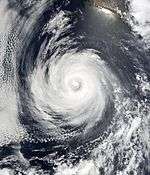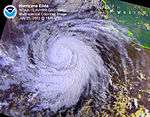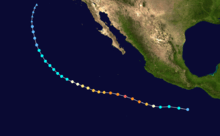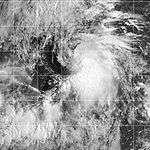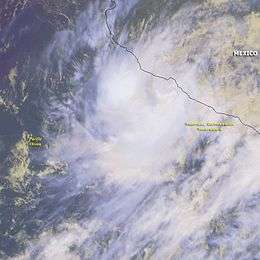2002 Pacific hurricane season
| |
| Season summary map |
| First system formed |
May 24, 2002 |
| Last system dissipated |
November 16, 2002 |
| Strongest storm1 |
Kenna – 913 mbar (hPa) (26.96 inHg), 165 mph (270 km/h) (1-minute sustained) |
| Total depressions |
19 official, 1 unofficial |
| Total storms |
15 |
| Hurricanes |
8 |
| Major hurricanes (Cat. 3+) |
6 |
| Total fatalities |
4 |
| Total damage |
$101 million (2002 USD) |
| 1Strongest storm is determined by lowest pressure |
Pacific hurricane seasons
2000, 2001, 2002, 2003, 2004 |
The 2002 Pacific hurricane season saw three tropical cyclones reach Category 5 intensity on the Saffir-Simpson Hurricane Wind Scale. The strongest storm this year was Hurricane Kenna, which reached Category 5 on the Saffir-Simpson Hurricane Scale. It made landfall near Puerto Vallarta, located in the Mexican state of Jalisco, on October 25. The hurricane killed four people and was the third most powerful hurricanes to ever strike the western coast of Mexico, hitting with winds of 140 mph (as well as the strongest landfall in terms of windspeed since Hurricane Madeline in 1976). Elsewhere, Tropical Storm Julio made landfall in Mexico, and Tropical Storm Boris dumped torrential rain along the Mexican coast, despite remaining offshore.
The season officially began on May 15, 2002 for the Eastern Pacific, and June 1, 2002 for the Central Pacific. It ended on November 30 for both regions. These dates delimit the time when most tropical cyclones form in this part of the Pacific Ocean. The first system formed on May 24 and the final depression dissipated on November 16.
Other storms were individually unusual. Hurricanes Elida and Hernan also reached Category 5 intensity, but neither caused any damage. Hurricane Fausto had no effect on land, but it regenerated into a weak tropical storm at an abnormally high latitude.
Season summary
The 2002 Pacific hurricane season officially started May 15, 2002 in the eastern Pacific, and June 1, 2002 in the central Pacific, and lasted until November 30, 2002. These dates conventionally delimit the period of each year when most tropical cyclones form in the northeastern Pacific Ocean.[1] In practice, however, the season lasted from May 24, the formation date of its first system, to November 16, the dissipation date of the last.[2]
There were 15 tropical storms in the eastern Pacific Ocean in the 2002 season. Of those, eight became hurricanes, of which six became major hurricanes by reaching Category 3 or higher on the Saffir Simpson Scale. Three reached Category 5 intensity,[2] a record shared with the 1994 season.[3] Four tropical depressions formed and dissipated before reaching the intensity of a tropical storm.[4] In the Central Pacific Hurricane Center's area of responsibility, one tropical storm and two hurricanes formed, with one of the hurricanes intensifying into a major hurricane.[2] In the eastern Pacific proper, the season saw below average activity in terms of the number of total storms and hurricanes, but about average activity in terms of major hurricanes.[5][6] A moderately strong El Niño, ongoing during the season, may have contributed to the disproportionate number of major hurricanes,[7] as well as reduced activity in the Atlantic.[8] Also of note was an unusual gap in storm formation during the first three weeks of August in this season,[2] histrocally a prime period for tropical cyclone formation.[9]
Only three systems, Tropical Storms Boris and Julio and Hurricane Kenna, had significant impact on land. Julio and Kenna caused the only two landfalls this year. Most of the season's impact, including all casualties and most of the damage, was caused by Kenna.[5]
May

Hurricane Alma at strong category 2 hurricane status.
- May 1
- 0700 UTC (12:00 a.m. PDT) – The Eastern Pacific hurricane season officially begins.[10]
- May 24
- 1800 UTC (5 a.m. PDT) – Tropical Depression One-E forms 485 miles (900 km) south-southeast of Manzanillo, Mexico.[11]
- May 26
- 1200 UTC (5 a.m. PDT) – Tropical Depression One-E strengthens into Tropical Storm Alma.[11]
- May 28
- 1800 UTC (5 a.m. PDT) – Tropical Storm Alma strengthens into a hurricane.[11]
- May 29
- 1800 UTC (5 a.m. PDT) – Hurricane Alma reaches category 2 strength.[11]
- May 30
- 0600 UTC (11 a.m. PDT) – Hurricane Alma becomes a major hurricane.[11]
- 1800 UTC (5 a.m. PDT) – Hurricane Alma weakens into a category 2 hurricane.[11]
- May 31
- 0600 UTC (11 p.m. PDT) – Hurricane Alma weakens into a category 1 hurricane.[11]
- 1200 UTC (5 a.m. PDT) – Hurricane Alma weakens into a tropical storm.[11]
June

Tracking Map of Tropical Storm Boris.
- June 1
- The Central Pacific hurricane season officially begins.[10]
- 0600 UTC (11 p.m. PDT) – Tropical Storm Alma weakens into a tropical depression.[11]
- 1200 UTC (5 a.m. PDT) – Tropical Depression Alma dissipates.[11]
- June 8
- 1200 UTC (5 a.m. PDT) – Tropical Depression Two-E forms 150 miles (280 km) west-southwest of Acapulco, Mexico.[12]
- June 9
- 0000 UTC (5 p.m. PDT) – Tropical Depression Two-E strengthens into Tropical Storm Boris.[12]
- June 10
- 1800 UTC (5 a.m. PDT) – Tropical Storm Boris weakens into a tropical depression.[12]
- June 11
- 1800 UTC (5 a.m. PDT) – Tropical Depression Boris degenerates into a remnant low pressure area.[12]
- June 27
- 1200 UTC (5 a.m. PDT) – Tropical Depression Three-E forms 970 miles (1795 km) southwest of the southern tip of the Baja Peninsula.[13]
- June 29
- 0600 UTC (11 p.m. PDT) – Tropical Depression Three-E dissipates.[13]
July
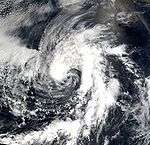
Image of Tropical Storm Cristina at peak strength.
- July 9
- 1200 UTC (5 a.m. PDT) – Tropical Depression Four-E forms 300 miles (555 km) south of Acapulco, Mexico.[14]
- July 12
- 0600 UTC (11 p.m. PDT) – Tropical Depression Four-E strengthens into Tropical Storm Cristina.[14]
- July 15
- 1200 UTC (5 a.m. PDT) – Tropical Storm Cristina weakens into a tropical depression.[14]
- July 17
- 0000 UTC (5 p.m. PDT) – Tropical Depression Cristina dissipates.[14]
- July 20
- 1200 UTC (5 a.m. PDT) – Tropical Depression Five-E forms 395 miles (730 km) south of Manzanillo, Mexico.[15]
- 1800 UTC (5 a.m. PDT) – Tropical Depression Five-E strengthens into Tropical Storm Douglas.[15]
- July 22
- 0000 UTC (5 p.m. PDT) – Tropical Storm Douglas becomes a hurricane.[15]
- 1200 UTC (5 a.m. PDT) – Hurricane Douglas strengthens to become a category 2 hurricane.[15]
- July 23
- 0600 UTC (11 p.m. PDT) – Tropical Depression Six-E forms 305 miles (565 km) south-southeast of Puerto Escondido, Mexico.[16]
- 1200 UTC (5 a.m. PDT) – Tropical Depression Six-E strengthens into Tropical Storm Elida.[16]
- 1800 UTC (5 a.m. PDT) – Hurricane Douglas weakens into a category 1 hurricane.[15]
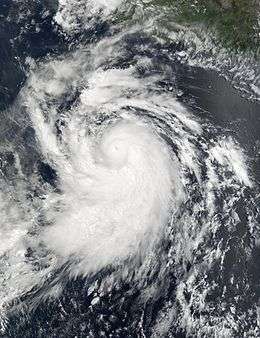
Image of Hurricane Elida near peak strength.
- July 24
- 0600 UTC (11 p.m. PDT) – Tropical Storm Elida strengthens into a hurricane.[16]
- 1200 UTC (5 a.m. PDT) – Hurricane Elida strengthens into a major hurricane, skipping category 2 status.[16]
- 1800 UTC (5 a.m. PDT) – Hurricane Elida strengthens into a category 4 hurricane.[16]
- 1800 UTC (5 a.m. PDT) – Hurricane Douglas weakens into a tropical storm.[15]
- July 25
- 0600 UTC (11 p.m. PDT) – Hurricane Elida becomes the first category 5 hurricane of the season.[16]
- 1200 UTC (5 a.m. PDT) – Hurricane Elida weakens into a category 4 hurricane.[16]
- July 26
- 0000 UTC (5 p.m. PDT) – Hurricane Elida weakens into a category 3 hurricane.[16]
- 0000 UTC (5 p.m. PDT) – Tropical Storm Douglas weakens into a tropical depression.[15]
- 1800 UTC (5 a.m. PDT) – Hurricane Elida weakens into a category 2 hurricane.[16]
- 1800 UTC (5 a.m. PDT) – Tropical Depression Douglas degenerates into a remnant low pressure area.[15]
- July 27
- 0600 UTC (11 p.m. PDT) – Hurricane Elida weakens into a category 1 hurricane.[16]
- 1800 UTC (5 a.m. PDT) – Hurricane Elida weakens into a tropical storm.[16]
- July 29
- 1800 UTC (5 a.m. PDT) – Tropical Storm Elida weakens into a tropical depression.[16]
- July 30
- 1800 UTC (5 a.m. PDT) – Tropical Depression Elida weakens into a remnant low pressure area.[16]
August

Tracking map of Hurricane Fausto.
- August 6
- 0000 UTC (5 p.m. PDT) – Tropical Depression Seven-E forms 785 miles (1455 km) southwest of the southern tip of the Baja Peninsula.[17]
- August 8
- 0600 UTC (11 p.m. PDT) – Tropical Depression Seven-E dissipates.[17]
- August 21
- 1200 UTC (5 a.m. PDT) – Tropical Depression Eight-E forms 400 miles (740 km) south-southwest of Manzanillo, Mexico.[18]
- August 22
- 0000 UTC (5 p.m. August 21 PDT) – Tropical Depression Eight-E strengthens into Tropical Storm Fausto.[18]
- 1800 UTC (5 a.m. PDT) – Tropical Storm Fausto becomes a hurricane.[18]
- 1800 UTC (2 a.m. HST) – Tropical Depression One-C forms over 1000 miles (1850 km) south of Hawaii.[19]

Tropical Storm Alika at peak intensity.
- August 23
- 1200 UTC (5 a.m. PDT) – Hurricane Fausto becomes a category 2 hurricane.[18]
- 1800 UTC (5 a.m. PDT) – Hurricane Fausto becomes a major hurricane.[18]
- August 24
- 0600 UTC (11 p.m. PDT) – Hurricane Fausto becomes a category 4 hurricane.[18]
- August 25
- 0000 UTC (2 p.m. August 24 HST) – Tropical Depression One-C strengthens into a tropical storm and is named Alika.[19]
- 0600 UTC (11 p.m. PDT) – Hurricane Fausto weakens into a category 3 hurricane.[18]
- 1200 UTC (5 a.m. PDT) – Hurricane Fausto weakens into a category 2 hurricane.[18]

Image of Tropical Storm Genevieve on August 28, 2002 at peak intensity.
- August 26
- 0000 UTC (5 p.m. PDT) – Tropical Depression Nine-E forms 500 miles (925 km) south of the Baja Peninsula.[20]
- 0600 UTC (11 p.m. PDT) – Hurricane Fausto weakens into a category 1 hurricane.[18]
- 1200 UTC (5 a.m. PDT) – Hurricane Fausto weakens into a tropical storm.[18]
- August 27
- 0000 UTC (2 p.m. August 26 HST) – Tropical Depression Two-C forms about 1000 miles (1850 km) southwest of the Hawaiian Islands.[21]
- 0000 UTC (5 p.m. PDT) – Tropical Depression Nine-E strengthens into a tropical storm and is named Genevieve.[20]
- 0000 UTC (2 p.m. August 26 HST) – Tropical Storm Alika weakens into a tropical depression.[19]
- 0600 UTC (8 p.m. HST) – Tropical Depression Two-C strengthens into a tropical storm and is named Ele.[21]

Hurricane Ele as it moved out of the Central Pacific Hurricane Center's Area of Responsibility.
- August 28
- 0000 UTC (2 p.m. August 27 HST) – Tropical Storm Ele strengthens into a hurricane.[21]
- 0000 UTC (5 p.m. PDT) – Tropical Storm Fausto weakens into a tropical depression as it crosses into the Central Pacific.[18]
- 0600 UTC (8 p.m. August 27 HST) – Tropical Depression Alika dissipates.[19]
- 1200 UTC (5 a.m. PDT) – Tropical Depression Fausto degenerates into a low.[18]
- August 29
- 0600 UTC (8 p.m. August 28 HST) – Hurricane Ele strengthens into a category 2 hurricane.[21]
- 1800 UTC (2 a.m. HST) – Hurricane Ele strengthens into a major hurricane.[21]
- August 30
- 0000 UTC (2 p.m. August 29 HST) – Hurricane Ele moves out of the Central Pacific and into the West Pacific where the JMA takes up warning responsibility.[21]
- 0600 UTC (11 p.m. PDT) – Tropical Depression Ten-E forms 340 miles (630 km) south-southwest of Manzanillo, Mexico.[22]
- 1200 TC (5 a.m. PDT) – Tropical Depression Ten-E strengthens into a tropical storm and is named Hernan.[22]
- 1200 UTC (5 a.m. PDT) – Tropical Storm Genevieve weakens into a tropical depression.[20]
- 1800 UTC (5 a.m. PDT) – Tropical Depression Fausto regenerates about 430 miles (795 km) north of the Hawaiian Islands.[18]
- August 31
- 0600 UTC (11 p.m. PDT) – Tropical Storm Hernan becomes a hurricane.[22]
- 1200 UTC (5 a.m. PDT) – Hurricane Hernan strengthens into a category 2 hurricane.[22]
- 1800 UTC (5 a.m. PDT) – Hurricane Hernan strengthens into a major hurricane.[22]
September
- September 1
- 0000 UTC (5 p.m. PDT) – Hurricane Hernan strengthens into a category 4 hurricane.[22]
- 0600 UTC (11 p.m. PDT) – Tropical Depression Genevieve dissipates.[20]
- 1200 UTC (5 a.m. PDT) – Hurricane Hernan strengthens into a category 5 hurricane.[22]
- 1800 UTC (5 a.m. PDT) – Tropical Depression Fausto re-strengthens into a tropical storm.[18]

Tracking map of Hurricane Hernan.
- September 2
- 0000 UTC (5 p.m. PDT) – Hurricane Hernan weakens into a category 4 hurricane.[22]
- 1200 UTC (5 a.m. PDT) – Hurricane Hernan weakens into a category 3 hurricane.[22]
- September 3
- 0000 UTC (5 p.m. PDT) – Hurricane Hernan weakens into a category 2 hurricane.[22]
- 0600 UTC (11 p.m. PDT) – Tropical Storm Fausto is absorbed by an extratropical low.[18]
- September 4
- 0000 UTC (5 p.m. PDT) – Hurricane Hernan weakens into a category 1 hurricane.[22]
- 1200 UTC (5 a.m. PDT) – Hurricane Hernan weakens into a tropical storm.[22]
- September 5
- 1200 UTC (5 a.m. PDT) – Tropical Storm Hernan weakens into a tropical depression.[22]
- September 6
- 0000 UTC (5 p.m. PDT) – Tropical Depression Eleven-E forms 120 miles (220 km) southwest of Cabo Corrientes, Mexico.[23]
- 1800 UTC (5 a.m. PDT) – Tropical Depression Hernan weakens into a remnant low pressure area.[22]
- September 8
- 1800 UTC (5 a.m. PDT) – Tropical Depression Eleven-E weakens into a remnant low pressure area.[23]
- September 15
- 0600 UTC (11 p.m. PDT) – Tropical Depression Twelve-E forms 270 miles (500 km) south of Manzanillo, Mexico.[24]

Image of Tropical Storm Iselle at peak intensity.
- September 16
- 0000 UTC (5 p.m. PDT) – Tropical Depression Twelve-E strengthens into a tropical storm and is named Iselle.[24]
- September 19
- 1800 UTC (5 a.m. PDT) – Tropical Storm Iselle weakens into a tropical depression.[24]
- September 20
- 0600 UTC (11 p.m. PDT) – Tropical Depression Iselle weakens into a remnant low pressure area.[24]

Tracking map of Tropical Storm Julio.
- September 25
- 0000 UTC (5 p.m. PDT) – Tropical Depression Thirteen-E forms 175 miles (325 km) southwest of Acapulco, Mexico.[25]
- 1200 UTC (5 a.m. PDT) – Tropical Depression Thirteen-E strengthens into a tropical storm and is named Julio.[25]
- September 26
- 0000 UTC (5 p.m. PDT) – Tropical Storm Julio makes landfall west-northwest of Lazaro Cardenas, Mexico with winds of 45 mph (70 km/h).[25]
- 1200 UTC (5 a.m. PDT) – Tropical Storm Julio weakens into a tropical depression.[25]
- 1800 UTC (11 a.m. PDT) – Tropical Depression Julio dissipates.[25]
October
- October 22
- 0000 UTC (5 p.m. PDT) – Tropical Depression Fourteen-E forms 325 miles (600 km) south of Acapulco, Mexico.[26]
- 0600 UTC (11 p.m. October 21 PDT) – Tropical Depression Fourteen-E strengthens into a tropical storm and is named Kenna.[26]
- 1800 UTC (5 a.m. PDT) – Tropical Depression Fifteen-E forms in the western portion of the Eastern Pacific.[27]
- October 23
- 0600 UTC (11 p.m. October 22 PDT) – Tropical Depression Fifteen-E strengthens into a tropical storm and is named Lowell.[27]
- 1800 UTC (5 a.m. PDT) – Tropical Storm Kenna strengthens into a hurricane.[26]
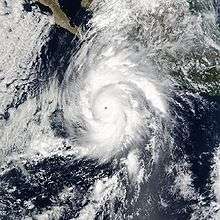
Hurricane Kenna at peak intensity off Mexico.
- October 24
- 0000 UTC (5 p.m. October 23 PDT) – Hurricane Kenna strengthens into a category 2 hurricane.[26]
- 0600 UTC (11 p.m. October 23 PDT) – Hurricane Kenna strengthens into a major hurricane.[26]
- 1200 UTC (5 a.m. PDT) – Hurricane Kenna strengthens into a category 4 hurricane.[26]
- 1800 UTC (5 a.m. PDT) – Hurricane Kenna strengthens into a category 5 hurricane.[26]
- 1800 UTC (11 a.m. PDT) – Tropical Storm Lowell weakens into a tropical depression.[27]
- 1800 UTC (2 a.m. PDT) – Tropical Depression Three-C forms south of the Hawaiian Islands.[28]

Tracking map of Tropical Storm Lowell.
- October 25
- 0000 UTC (5 p.m. October 24 PDT) – Hurricane Kenna becomes the strongest of the season with winds of 165 mph (265 km/h) and a pressure of 913 mbar (26.96 inHg).[26]
- 1200 UTC (5 a.m. PDT) – Hurricane Kenna weakens into a category 4 hurricane.[26]
- 1630 UTC - Hurricane Kenna makes landfall near San Blas, Mexico with winds of 140 mph (225 km/h), only the 1959 Mexican hurricane and Hurricane Madeline of 1976 are stronger at landfall.[26]
- 1800 UTC (5 a.m. PDT) – Hurricane Kenna weakens into a category 3 hurricane.[26]
- October 26
- 0000 UTC (2 p.m. October 25 HST) – Tropical Depression Three-C strengthens into a tropical storm and is named Huko.[28]
- 0000 UTC (5 p.m. PDT) – Hurricane Kenna rapidly weakens into a tropical storm over Mexico.[26]
- 0600 UTC (11 p.m. PDT) – Tropical Storm Kenna dissipates.[26]
- October 27
- 1800 UTC (5 a.m. PDT) – Tropical Depression Lowell re-strengthens into a tropical storm.[27]
- October 28
- 1800 UTC (5 a.m. PDT) – Tropical Storm Huko strengthens into a hurricane.[28]
- October 29
- 1200 UTC (5 a.m. PDT) – Tropical Storm Lowell again weakens into a tropical depression.[27]
- October 30
- 0000 UTC (2 p.m. October 29 HST) – Hurricane Huko weakens into a tropical storm.[28]
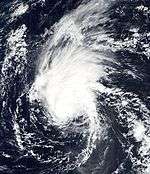
Hurricane Huko at peak intensity on November 1.
- October 31
- 0000 UTC (5 p.m. PDT) – Tropical Depression Lowell dissipates.[27]
- 0600 UTC (11 p.m. October 30 HST) – Tropical Storm Huko again strengthens into a hurricane.[28]
November
- November 3
- 0600 UTC (8 p.m. November 2 HST) – Hurricane Huko moves out of the Central Pacific Hurricane Center's Area of Responsibility.[28]
- November 14
- 0000 UTC (5 p.m. PDT) – Tropical Depression Sixteen-E forms 370 miles (685 km) south of Acapulco, Mexico.[29]
- November 16
- 0600 UTC (11 p.m. PDT) – Tropical Depression Sixteen-E weakens into a remnant low pressure area.[29]
- November 30
- The Eastern and Central Pacific hurricane seasons officially ends.[10]
In addition to the above systems, an area of convection persisted near a developing circulation about 575 mi (925 km) west-southwest of Johnston Atoll on July 18. An upper-level low to the northeast provided outflow, and the Joint Typhoon Warning Center issued a tropical cyclone formation alert early on July 19.[30] Although not classified by the CPHC, the Japan Meteorological Agency remarked that a tropical depression had developed by early on July 20, just east of the International Date Line. Soon after, it crossed into the western Pacific and briefly intensified into Tropical Storm Kalmaegi.[31]
Storms
|-
Hurricane Alma
| Category 3 hurricane (SSHWS) |
|
|
| Duration |
May 24 – June 1 |
| Peak intensity |
115 mph (185 km/h) (1-min) 960 mbar (hPa) |
A complex formation involving a tropical wave and a gale over the Gulf of Tehuantepec formed Tropical Depression One-E on May 24. It slowly strengthened into the first tropical storm of the season two days later. Alma then turned north, moving near the edge of a subtropical ridge over Mexico. Its rate of intensification picked up, and Alma became a hurricane on May 28. Alma reached Category 3 intensity on May 30. The hurricane began to weaken almost immediately thereafter under the influence of wind shear and cool water. Alma rapidly fell apart, and degenerated into a weak low pressure area by June 1.[32]
The hurricane did not impact land.[32] A special feature about Alma was that it was one of only five Pacific major hurricanes in May.[2]
Tropical Storm Boris
| Tropical storm (SSHWS) |
|
|
| Duration |
June 8 – June 11 |
| Peak intensity |
60 mph (95 km/h) (1-min) 997 mbar (hPa) |
On June 8, an area of disturbed weather that had absorbed a tropical wave spawned Tropical Depression Two-E. It became a tropical storm the next day. After peaking on June 9, with a pressure of 997 mb, steering currents collapsed and Boris stalled out in the ocean between two ridges of high pressure. Shear increased, and the cyclone weakened to a depression on June 10. The next day, Boris degenerated into a remnant low. The remnant drifted east and then southeast before dissipating on June 12.[33]
Boris dumped heavy rains on sections of the Mexican coast. The maximum amount was 10.60 inches (269 mm) at San Felipe Usila.[34] These rains damaged several homes at an unspecified location. In addition, rainfall damaged several homes in Tequila, Jalisco, but the National Hurricane Center believes that Boris likely did not cause the rain. No deaths were attributed to this storm.[33]
Tropical Depression Three-E
| Tropical depression (SSHWS) |
|
|
| Duration |
June 27 – June 29 |
| Peak intensity |
35 mph (55 km/h) (1-min) 1006 mbar (hPa) |
A tropical wave that crossed Central America organized and developed into a tropical depression on June 27.[35] Contrary to forecasts,[36] the depression did not strengthen further because of strong wind shear. By June 29, the depression had become a remnant low, which was observed as a swirl of clouds for a few more days before dissipating.[35]
Tropical Storm Cristina
| Tropical storm (SSHWS) |
|
|
| Duration |
July 9 – July 16 |
| Peak intensity |
65 mph (100 km/h) (1-min) 994 mbar (hPa) |
An area of disturbed weather near Panama drifted to a location south of Puerto Ángel, Oaxaca, and organized into Tropical Depression Four-E on July 9. It moved westward through a hostile environment of strong shear. The wind shear disrupted the cyclone's convection and weakened its circulation. Despite the shear, the depression strengthened into a tropical storm early on July 12 and was named Cristina. This broke down the steering ridge, and Cristina turned to the north and peaked on July 14. Then, the wind shear won out and Cristina quickly weakened. Cristina dissipated into a swirl of clouds on July 16, without ever threatening land. No impact was reported.[37]
Hurricane Douglas
| Category 2 hurricane (SSHWS) |
|
|
| Duration |
July 20 – July 26 |
| Peak intensity |
105 mph (165 km/h) (1-min) 970 mbar (hPa) |
A tropical wave exited the west coast of Africa on July 8 and crossed the Atlantic without much development. In the Caribbean, showers increased, but wind shear prevented development. The wave crossed into the eastern Pacific on July 16, and wind shear decreased to allow the convection to organize. Tropical Depression Five-E developed on July 20 about 395 miles (636 km) south of Manzanillo, Mexico.[38] At that time, gradual strengthening was anticipated.[39] The depression quickly intensified into Tropical Storm Douglas.[38] Around that time, most of the deep convection was situated south of the atmospheric circulation.[40] Initially expected to become a hurricane only briefly,[41] late on July 21, the NHC reported that Douglas had become a hurricane.[42] Upon becoming a hurricane, Douglas was situated in low wind shear environment; however, Hurricane Douglas was expected to reach cold waters in 36 hours, and thus was not predicted to become a major hurricane.[43] Douglas became a Category 2 hurricane on July 22, reaching peak winds of 105 miles per hour (170 km/h).[44] Douglas held this intensity for 18 hours as it traveled westward.[38] When Douglas weakened from its peak intensity, it had an organized cloud pattern, but the thunderstorm activity was weakening, typical of most Pacific hurricanes that reach cooler waters.[45] The weakening briefly stopped after Douglas went through an eyewall replacement cycle,[46] but Douglas was downgraded to a tropical storm late on July 24 as the storm only had a small area of deep convection left.[38] Tropical storm Douglas briefly stopped weakening as convection increased, only to fade away again hours later.[47] The storm was downgraded to a tropical depression early on July 26,[38] and later that day degenerated into a remnant low pressure area.[48] The remnant low dissipated the next day.[38]
Hurricane Elida
| Category 5 hurricane (SSHWS) |
|
|
| Duration |
July 23 – July 30 |
| Peak intensity |
160 mph (260 km/h) (1-min) 921 mbar (hPa) |
A tropical wave generated into Tropical Depression Six-E on July 23. It moved westward and reached storm strength 12 hours after it formed. Elida rapidly deepened, developing a pinhole eye, and becoming a hurricane on July 24 and further reaching major hurricane intensity six hours later. Elida's rapid intensification continued, becoming a Category 5 hurricane for six hours on July 25.[49]
Despite moving over warm waters, Elida began to weaken because it began an eyewall replacement cycle. When the cycle ended, the cyclone was over cooler water and unsteadily weakened. Elida fell to a tropical storm on July 27, then degenerated into a remnant low and turned to the northeast. The remnant dissipated over the open ocean about 535 mi (861 km) west of Los Angeles.[49]
Elida is one of the fastest intensifying eastern Pacific hurricanes. Its rate of intensification is rivaled only by 1997's Linda and 2015's Patricia. Elida had no direct impact on land. However, it did send heavy waves along the shores of Mexico. No one was killed and no damage was reported.[49]
Tropical Depression Seven-E
| Tropical depression (SSHWS) |
|
|
| Duration |
August 6 – August 8 |
| Peak intensity |
35 mph (55 km/h) (1-min) 1008 mbar (hPa) |
A tropical wave that had reached the Eastern Pacific from Africa was first spotted on July 23. The wave continued westward with little development occurring until August 3, when convection increased. After additional slow organization, the wave was classified as Tropical Depression Seven-E on August 6 near the tip of Baja California. The system did not strengthen much, and development was halted when wind shear destroyed the system on August 8. The depression never came near land and hence no one was killed or injured.[50] Like Tropical Depression Three-E, this cyclone was forecast to reach tropical storm intensity, but it never did.[51]
Hurricane Fausto
| Category 4 hurricane (SSHWS) |
|
|
| Duration |
August 21 – September 3 |
| Peak intensity |
145 mph (230 km/h) (1-min) 936 mbar (hPa) |
After a rather lengthy lull punctuated by only Tropical Depression Seven-E, a tropical wave formed Tropical Depression Eight-E on August 21. Initially taking a westward track, the depression strengthened into Tropical Storm Fausto on August 22. It turned to the west-northwest and stayed on that path for the next six days. Fausto steadily strengthened and intensified into a hurricane on August 22. It continued to intensify, peaking as a Category 4 on August 24, and also substantially increased in size. The hurricane began to weaken thereafter, and was a minimal tropical storm by the time it entered the Central Pacific Hurricane Center's area of responsibility on August 27.[52] The tropical cyclone dropped to a depression and degenerated into a non-convective swirl of clouds on August 28.[53]
Fausto's remnants passed north of the Hawaiian Islands uneventfully until they interacted with a tropical upper-tropospheric trough (TUTT) on August 30. In combination with warm waters, a tropical depression with some subtropical features developed. At this time it was located around latitude 30°N. By September 1, Fausto had redeveloped into a tiny but tropical ministorm. Its rebirth was brief, however, as a mid-latitude cyclone absorbed the system early on September 3.[52]
Fausto's regeneration north of Hawaii was unusual but not unprecedented. The other time this happened since 1966 was in the 1975 season. That time, another TUTT absorbed the remnant of Hurricane Ilsa, which led to the formation of an unnamed hurricane at high latitude. Other tropical cyclones have strengthened north of Hawaii, but the actual formation of one is rare.[53]
Tropical Storm Alika
| Tropical storm (SSHWS) |
|
|
| Duration |
August 22 – August 28 |
| Peak intensity |
65 mph (100 km/h) (1-min) 995 mbar (hPa) |
An area of convection acquired a closed circulation and became Tropical Depression One-C on August 22. It stayed disorganized for the next several days. It organized more fully and intensified into a tropical storm on August 25 and was named Alika. After peaking as a moderately strong tropical storm on August 25, wind shear caused by the pre-Ele tropical depression and an upper-level low near Hawaii weakened the storm to a depression on August 27. Alika dissipated the next day, having never threatened land.[53]
Tropical Storm Genevieve
| Tropical storm (SSHWS) |
|
|
| Duration |
August 26 – September 1 |
| Peak intensity |
70 mph (110 km/h) (1-min) 989 mbar (hPa) |
A tropical wave formed Tropical Depression Nine-E on August 26. It was upgraded to a tropical storm and named Genevieve the next day. It moved westward and nearly strengthened to a hurricane, peaking in intensity on August 28. At that point, the cyclone encountered cooler waters, which caused it to weaken slowly, weakening to a depression on August 30. The depression hung on until it lost convection on the September 2. A swirl of remnant clouds persisted for a few more days. Genevieve had no impact on land, with no reports of casualties or damage being received by the National Hurricane Center.[54]
Hurricane Ele
| Category 3 hurricane (SSHWS) |
|
|
| Duration |
August 27 – August 30 (Exited Basin) |
| Peak intensity |
125 mph (205 km/h) (1-min) 945 mbar (hPa) |
An eastern extension of the monsoon trough south of Hawaii organized into Tropical Depression Two-C on August 27 and strengthened into Tropical Storm Ele six hours later. Despite the nearby presence of Alika, Ele developed rapidly and strengthened into a hurricane on August 28. After contributing to the dissipation of Alika, Ele continued intensifying. It reached Category 2 intensity late on August 28 and quickly became a major hurricane six hours later. The hurricane then crossed the International Date Line and became a typhoon in the 2002 Pacific typhoon season. Typhoon Ele turned to the northwest after crossing the dateline and continued to strengthen. It reached Category 4 before turning north and weakening again. After briefly restrengthening back into a Category 4, the typhoon weakened and turned to the northwest. Ele was downgraded to a tropical storm on September 7, a depression on September 9, and then dissipated shortly afterwards. Ele did not affect land.[53]
Hurricane Hernan
| Category 5 hurricane (SSHWS) |
|
|
| Duration |
August 30 – September 6 |
| Peak intensity |
160 mph (260 km/h) (1-min) 921 mbar (hPa) |
A weak wave in the ITCZ organized into Tropical Depression Ten-E on August 30. It headed west-northwest and quickly intensified into a tropical storm and eventually, a hurricane. Hernan then began rapidly deepening, reaching Category 5 intensity on September 1. It maintained that intensity for 12 hours before tracking over cooler waters. The storm weakened steadily, with wind shear contributing to its deterioration. Hernan then degenerated into a remnant low on September 6. The low turned to the southwest and dissipated three days later.[55]
Hernan passed close enough to Socorro Island to bring strong winds to the island.[55] In addition, the hurricane's large and powerful wind field caused waves between 12 foot (3.7 m) and 20 foot (6.1 m) in height and strong rip currents on the southwest coast of California.[56] Other than the aforementioned regions, Hernan had no significant impact on land.[55]
Tropical Depression Eleven-E
| Tropical depression (SSHWS) |
|
|
| Duration |
September 5 – September 8 |
| Peak intensity |
35 mph (55 km/h) (1-min) 1006 mbar (hPa) |
Of the four tropical depressions this season that did not become named storms, only Eleven-E threatened land. An area of disturbed weather associated with a tropical wave formed into a tropical cyclone on September 5. It tracked northwestward, before turning southwest. It weakened into a remnant low on September 8. The remnant turned north and dissipated on September 10 offshore of the Baja California peninsula. The cyclone was nearly a tropical storm when it peaked on September 6. It was forecast to become a tropical storm and pass close to the peninsula. This prompted a tropical storm warning and a hurricane watch. With the weakening of the cyclone the watch and warning were discontinued. No damage or casualties were reported in association with this tropical cyclone.[57]
Tropical Storm Iselle
| Tropical storm (SSHWS) |
|
|
| Duration |
September 15 – September 20 |
| Peak intensity |
70 mph (110 km/h) (1-min) 990 mbar (hPa) |
Part of the same tropical wave that formed Tropical Depression Seven in the Atlantic basin organized into Tropical Depression Twelve-E on September 15. It strengthened further into Tropical Storm Iselle the next day. The storm headed northwest and paralleled the coast of Mexico, nearly strengthening into a hurricane late on September 17. While near its peak intensity, a trough abruptly recurved the system to the northeast. Wind shear also increased, and Iselle consequently fell apart on satellite imagery. It weakened to a depression on September 19. Iselle then degenerated into a remnant low the next day and rapidly degenerated, dissipating on September 20. Iselle never made landfall.[58]
Iselle threatened parts of southwestern Mexico and warnings and watches were issued for that area. Heavy rains were reported over parts of the Baja California Peninsula.[58] The highest amount of rainfall was 6.16 inches (156 mm) at Guadeloupe and Mulege, Baja California Sur.[59] There were no reports of damage or casualties.[58]
Tropical Storm Julio
| Tropical storm (SSHWS) |
|
|
| Duration |
September 25 – September 26 |
| Peak intensity |
45 mph (75 km/h) (1-min) 1000 mbar (hPa) |
An area of convection and disturbed weather, possibly related to outflow from Hurricane Isidore in the Atlantic basin, developed a circulation on September 23 and organized into Tropical Depression Thirteen-E on September 25. The depression headed northward and strengthened into a tropical storm that same day. Julio turned to the northwest and peaked in intesty as a minial tropical storm near Lázaro Cárdenas, Michoacán. On September 26, Juli made landfall. The storm rapidly dissipated over Mexico.[60]
Three fatalities were reported from Julio. However, in Guerrero, around 100 houses in Acapulco and Zihuatanejo were damaged or washed away by flash flooding.[60] The highest rainfall reported was 16.10 inches (409 mm) at Zihuatanejo and La Unión, Guerrero.[61]
Hurricane Kenna
| Category 5 hurricane (SSHWS) |
|
|
| Duration |
October 22 – October 26 |
| Peak intensity |
165 mph (270 km/h) (1-min) 913 mbar (hPa) |
A disturbance possibly associated with a tropical wave organized into Tropical Depression Fourteen-E on October 22. It strengthened into a tropical storm that same day and a hurricane on October 23. The next day, Kenna became the third Category 5 hurricane of the season. A trough over Mexico recurved the hurricane, and it started accelerating towards Mexico. Despite moving over waters that were still warm, wind shear weakened the system to a minimal Category 4 by the time of its landfall over Mexico late on October 25. Mountainous terrain rapidly weakened Kenna, and the system dissipated early on October 26.[62]
Hurricane Kenna was the third-strongest Pacific hurricane to make landfall on record.[62] It was also the second-strongest October hurricane in any season, and the third strongest Pacific hurricane overall.[2] In San Blas, Nayarit, 8,800 people were affected; 1,540 houses were damaged or destroyed,[63] which was 80% to 90% of houses in the town.[62] In Santiago Ixcluintla, 3,770 houses were damaged. Agriculture in the affected area was disrupted. Farmers required aid, and many fruit crops were destroyed. Tourism in Puerto Vallarta was disrupted,[63] with much of the damage to hotels. Insurance companies reported that Kenna's total damage was $96 million (2002 USD).[64]
Kenna killed four people in Mexico and injured over a hundred. The low death toll is likely due to massive evacuations in San Blas, Nayarit, and elsewhere ahead of the hurricane.[62]
Tropical Storm Lowell
| Tropical storm (SSHWS) |
|
|
| Duration |
October 22 – October 31 |
| Peak intensity |
50 mph (85 km/h) (1-min) 1002 mbar (hPa) |
A weak tropical wave located over the open Pacific Ocean organized into Tropical Depression Fifteen-E on October 22. It strengthened into a tropical storm the next day. Shortly afterwards, wind shear increased. Lowell's convection was disrupted, and its center of circulation became exposed. The cyclone crossed into the Central Pacific Hurricane Center's area of responsibility on October 26. The shear relaxed, and the depression restrengthened into a tropical storm. Lowell drifted in slow steering currents until it approached Hurricane Huko. The proximity of Huko caused a gradual weakening in Lowell, and it dissipated on October 31.[65]
Hurricane Huko
| Category 1 hurricane (SSHWS) |
|
|
| Duration |
October 24 – November 3 (Exited basin) |
| Peak intensity |
85 mph (140 km/h) (1-min) 980 mbar (hPa) |
In late October, an active monsoon trough persisted south of Hawaii along 10°N latitude, developing an area of convection on October 24. Later that day, the disturbance was classified as Tropical Depression Three-C about 850 mi (1,370 km) south-southeast of Honolulu. Initially poorly organized, it moved to the north and steadily intensified, becoming Tropical Storm Huko early on October 26 while turning northwestward. Late on October 28, Huko reached hurricane strength, but its close proximity to Tropical Storm Lowell and a brief increase in wind shear weakened it back to a tropical storm on October 30. Shortly after turning to the west, conditions allowed for Huko to re-attain hurricane strength on October 31 while it was passing around 140 mi (225 km) south of Johnston Atoll. On November 2, a ridge caused the hurricane to accelerate, and the next day it crossed the International Date Line into the Western Pacific, becoming a typhoon.[53][66]
While passing near Johnston Atoll, the outer rainbands of the hurricane produced wind gusts up to 30 mph (48 km/h) and locally heavy rainfall.[66] The remnants of Huko later reentered the basin, eventually affecting California. The system was responsible for heavy rains, causing flooding along a small stream in Bakersfield. Total damage was approximately $23,000 (2002 USD).[67]
Tropical Depression Sixteen-E
| Tropical depression (SSHWS) |
|
|
| Duration |
November 14 – November 16 |
| Peak intensity |
35 mph (55 km/h) (1-min) 1006 mbar (hPa) |
Tropical Depression Sixteen-E formed from a disturbance in the intertropical convergence zone. Despite being located in a hostile environment, it managed to organize into a tropical depression on November 14.[68] It was briefly forecast to strengthen into a tropical storm.[69] However, wind shear prevented that from occurring. Consequently, the depression degenerated into a remnant low on November 16 and dissipated soon after that.[68]
Other storms
Tropical Depression Kalmaegi
| Tropical depression (SSHWS) |
|
|
| Duration |
July 17 – July 20 (Exited basin) |
| Peak intensity |
30 mph (45 km/h) (1-min) 1002 mbar (hPa) |
According to the Joint Typhoon Warning Center and Japan Meteorological Agency, on July 17 a tropical depression formed east of the International Dateline, and 3 days later it exited CPHC's area of responsibility;[70][71] however, this storm wasn't included into CPHC database. As it entered into western Pacific, it strenghened as a tropical storm and received the name Kalmaegi.
Accumulated Cyclone Energy
| Accumulated Cyclone Energy |
| Rank | Name | ACE | Rank | Name | ACE |
| 1 |
Hernan |
20.0 |
9 |
Genevieve |
3.60 |
| 2 |
Elida |
18.1 |
10 |
Iselle |
3.15 |
| 3 |
Fausto |
16.6 (0.735) |
11 |
Cristina |
2.46 |
| 4 |
Kenna |
14.2 |
12 |
Lowell |
0.885 (1.09) |
| 5 |
Huko |
(12.9) |
13 |
Alika |
(1.74) |
| 6 |
Alma |
10.3 |
14 |
Boris |
1.40 |
| 7 |
Douglas |
9.33 |
15 |
Julio |
0.565 |
| 8 |
Ele |
(7.24) |
| Total ACE: 101 (23.7) 104 kn2 |
Accumulated Cyclone Energy (ACE) is a measure of the activity of a hurricane season. It is calculated by squaring the windspeed of a cyclone with at least tropical storm-force winds every six hours, summing the results, and dividing that total by 104.[6] As a tropical cyclone does not have gale-force winds until it becomes a tropical storm, tropical depressions are not included in these tables. For all storms, ACE is given to three significant figures. The ACE in the east Pacific proper (140°W to North America) is given; the ACE in the central Pacific (the International Date Line to 140°W) is given in parentheses.
The table includes the ACE for Ele and Huko accumulated only when those storms were located east of the dateline; their ACE west of the dateline is part of the totals of the 2002 typhoon season.
The National Hurricane Center uses ACE to rank hurricane seasons as above-normal, near-normal, and below-normal. It defines below-normal as having an ACE less than 95*104 kn2; It defines above normal as having an ACE above 150*104 kn2 along with the numbers of any two of the following above average: tropical storms (15), hurricanes (9), or major hurricanes (4); It defines near-normal as having an ACE between 100*104 kn2 and 150*104 kn2, or an ACE above 150*104 kn2 with fewer than two of the numbers of the following above average: tropical storms (15), hurricanes (9), or major hurricanes (4).[6]
The 2002 season had a total of fifteen tropical storms, eight hurricanes, and 6 major hurricanes.[2] The total ACE of the season was 101*104 kn2 in the east Pacific proper. This qualifies the 2002 season as near to slightly above normal.[72]
Storm names
The following names were used for named storms that formed in the Northeastern Pacific Ocean during 2002. The names not retired from this list were used again in the 2008 season. This is the same list used for the 1996 season.[2] Names that were not assigned are marked in gray.
|
|
- Iselle
- Julio
- Kenna
- Lowell
-
Marie (unused)
-
Norbert (unused)
-
Odile (unused)
-
Polo (unused)
|
-
Rachel (unused)
-
Simon (unused)
-
Trudy (unused)
-
Vance (unused)
-
Winnie (unused)
-
Xavier (unused)
-
Yolanda (unused)
-
Zeke (unused)
|
For storms that form in the Central Pacific Hurricane Center's area of responsibility, encompassing the area between 140 degrees west and the International Date Line, all names are used in a series of four rotating lists. The next four names that were slated for use in 2002 are shown below. Three of them, Alika, Ele, and Huko, were used throughout the course of the year.
Retirement
The World Meteorological Organization retired one name in the spring of 2003, Kenna.[73] It was replaced in the 2008 season by Karina.[74]
See also
References
- ↑ Neal Dorst. "Subject: G1) When is hurricane season?". FAQ: Hurricanes, Typhoons, and Tropical Cyclones. Atlantic Oceanographic and Meteorological Laboratory Hurricane Research Division. Archived from the original on May 5, 2009. Retrieved September 14, 2008.
- 1 2 3 4 5 6 7 8 "Eastern North Pacific Tracks File 1949–2007". National Hurricane Center. March 21, 2008. Archived from the original (Plaintext) on August 22, 2008. Retrieved September 13, 2008.
- ↑ "The 1994 Central Pacific Tropical Cyclone Season". Central Pacific Hurricane Center. Retrieved September 14, 2008.
- ↑ "2002 Eastern Pacific Hurricane Season". National Hurricane Center. Archived from the original on 17 September 2008. Retrieved September 14, 2008.
- 1 2 Franklin, Avila, Beven, Lawrence, Pasch, & Stewart (November 30, 2002). "Monthly Tropical Weather Summary". National Hurricane Center. Archived from the original on 22 September 2008. Retrieved September 16, 2008.
- 1 2 3 "Background Information: Eastern Pacific Hurricane Season". Climate Prediction Center. Archived from the original on May 18, 2009. Retrieved September 16, 2008.
- ↑ "Figure 19. Tropical Storms, El Niño, and the Southwest". University of Arizona. August 2002. Retrieved September 16, 2008.
- ↑ Gerald Bell, Eric Blake, Muthuvel Chelliah, Stanley Goldenberg, Chris Landsea, & Richard Pasch. "The 2002 North Atlantic Hurricane Season" (PDF). Climate Prediction Center. Archived (PDF) from the original on 24 September 2008. Retrieved September 16, 2008.
- ↑ "Tropical Cyclone Climatology". National Hurricane Center. Archived from the original on 15 September 2008. Retrieved September 14, 2008.
- 1 2 3 Atlantic Oceanographic and Meteorological Laboratory, Hurricane Research Division. "Frequently Asked Questions: When is hurricane season?". National Oceanic and Atmospheric Administration. Retrieved 2008-10-22.
- 1 2 3 4 5 6 7 8 9 10 National Hurricane Center (2002). "Hurricane Alma Tropical Cyclone Report". National Hurricane Center. Retrieved 2008-10-24.
- 1 2 3 4 National Hurricane Center (2002). "Tropical Storm Boris Tropical Cyclone Report". National Hurricane Center. Retrieved 2008-10-24.
- 1 2 National Hurricane Center (2002). "TD 3-E Tropical Cyclone Report". National Hurricane Center. Retrieved 2008-10-24.
- 1 2 3 4 National Hurricane Center (2002). "Tropical Storm Cristina Tropical Cyclone Report". National Hurricane Center. Retrieved 2008-10-24.
- 1 2 3 4 5 6 7 8 National Hurricane Center (2002). "Hurricane Douglas Tropical Cyclone Report". National Hurricane Center. Retrieved 2008-10-24.
- 1 2 3 4 5 6 7 8 9 10 11 12 13 National Hurricane Center (2002). "Hurricane Elida Tropical Cyclone Report". National Hurricane Center. Retrieved 2008-10-24.
- 1 2 National Hurricane Center (2002). "TD 7-E Tropical Cyclone Report". National Hurricane Center. Retrieved 2008-10-24.
- 1 2 3 4 5 6 7 8 9 10 11 12 13 14 15 National Hurricane Center (2002). "Hurricane Fausto Tropical Cyclone Report". National Hurricane Center. Retrieved 2008-10-24.
- 1 2 3 4 "Tropical Cyclone Report:Tropical Storm Alika". Central Pacific Hurricane Center. May 2003. Retrieved 2009-04-09.
- 1 2 3 4 Avila, Lixion A. (October 12, 2002). "Tropical Cyclone Report:Tropical Storm Genevieve". National Hurricane Center. Retrieved 2009-04-09.
- 1 2 3 4 5 6 "Tropical Cyclone Reports:Hurricane Ele". Central Pacific Hurricane Center. May 2003. Retrieved 2009-04-09.
- 1 2 3 4 5 6 7 8 9 10 11 12 13 14 Lawrence, Miles B. (December 12, 2002). "Tropical Cyclone Report:Hurricane Hernan". National Hurricane Center. Retrieved 2009-04-09.
- 1 2 Pasch, Richard J. (January 13, 2003). "Tropical Cyclone Report:Tropical Depression Eleven-E". National Hurricane Center. Retrieved 2009-04-09.
- 1 2 3 4 Stewart, Stacy R. (November 10, 2002). "Tropical Cyclone Report:Tropical Storm Iselle". National Hurricane Center. Retrieved 2009-04-09.
- 1 2 3 4 5 Beven, Jack (December 11, 2002). "Tropical Cyclone Report:Tropical Storm Julio". National Hurricane Center. Retrieved 2009-04-09.
- 1 2 3 4 5 6 7 8 9 10 11 12 13 Franklin, James L. (December 26, 2002). "Tropical Cyclone Report:Hurricane Kenna". National Hurricane Center. Retrieved 2009-04-09.
- 1 2 3 4 5 6 Avila, Lixion A. (December 27, 2002). "Tropical Cyclone Report: Tropical Storm Lowell". National Hurricane Center. Retrieved 2009-04-09.
- 1 2 3 4 5 6 "Tropical Cyclone Report:Hurricane Huko". Central Pacific Hurricane Center. May 2003. Retrieved 2009-04-09.
- 1 2 Lawrence, Miles B. (December 4, 2002). "Tropical Cyclone Report:Tropical Depression Sixteen-E". National Hurricane Center. Retrieved 2009-04-09.
- ↑ Gary Padgett (2002). "Monthly Global Tropical Cyclone Summary July 2002". Retrieved 2012-10-14.
- ↑ Annual Report on Activities of the RSMC Tokyo – Typhoon Center 2002 (PDF) (Report). Japan Meteorological Agency. 13. Retrieved 2012-08-27.
- 1 2 Stacy Stewart (July 24, 2002). "Tropical Cyclone Report Hurricane Alma". National Hurricane Center. Archived from the original on 22 September 2008. Retrieved September 13, 2008.
- 1 2 James Franklin (June 24, 2002). "Tropical Cyclone Report Tropical Storm Boris". National Hurricane Center. Archived from the original on 22 September 2008. Retrieved September 13, 2008.
- ↑ David M. Roth. "Tropical Storm Boris — June 5–12, 2002" (GIF). Hydrometeorological Prediction Center. Archived from the original on 19 October 2008. Retrieved September 13, 2008.
- 1 2 Lixion Avila (July 6, 2002). "Tropical Depression Report Tropical Depression Three-E". National Hurricane Center. Archived from the original on 22 September 2008. Retrieved September 13, 2008.
- ↑ Lawrence (June 27, 2002). "Tropical Depression Three-E Discussion Number 1". National Hurricane Center. Archived from the original on 21 October 2008. Retrieved September 13, 2008.
- ↑ Miles Lawrence & Eric Blake (November 30, 2002). "Tropical Cyclone Report Tropical Storm Cristina". National Hurricane Center. Archived from the original on 22 September 2008. Retrieved September 13, 2008.
- 1 2 3 4 5 6 Richard Pasch (December 13, 2002). "Tropical Cyclone Report Hurricane Douglas". National Hurricane Center. Archived from the original on 22 September 2008. Retrieved September 13, 2008.
- ↑ Lixion A. Avila (2002). "Hurricane Douglas Discussion 1". National Hurricane Center. Retrieved 2008-10-05.
- ↑ Miles B. Lawrence (2002). "Hurricane Douglas Discussion 2". National Hurricane Center. Retrieved 2008-10-05.
- ↑ James Franklin (2002). "Hurricane Douglas Discussion 3". National Hurricane Center. Retrieved 2008-10-05.
- ↑ Stacy R. Stewart (2002). "Hurricane Douglas Discussion 7". National Hurricane Center. Retrieved 2008-10-05.
- ↑ Richard J. Pasch (2002). "Hurricane Douglas Discussion 8". National Hurricane Center. Retrieved 2008-10-05.
- ↑ Miles B. Lawrence (2002). "Hurricane Douglas Discussion 9". National Hurricane Center. Retrieved 2008-10-05.
- ↑ Lixion A. Avila (2002). "Hurricane Douglas Discussion 13". National Hurricane Center. Retrieved 2008-10-05.
- ↑ Jack Beven (2002). "Hurricane Douglas Discussion 15". National Hurricane Center. Retrieved 2008-10-05.
- ↑ Jack Beven (2002). "Hurricane Douglas Discussion 19". National Hurricane Center. Retrieved 2008-10-05.
- ↑ Lixion A. Avila (2002). "Hurricane Douglas Discussion 25". National Hurricane Center. Retrieved 2008-10-05.
- 1 2 3 Jack Beven (December 13, 2002). "Tropical Cyclone Report Hurricane Elida". National Hurricane Center. Archived from the original on 22 September 2008. Retrieved September 13, 2008.
- ↑ Jack Beven (November 20, 2002). "Tropical Cyclone Report Tropical Depression Seven-E". National Hurricane Center. Archived from the original on 22 September 2008. Retrieved September 13, 2008.
- ↑ Franklin (August 6, 2002). "Tropical Depression Seven-E Discussion 1". National Hurricane Center. Archived from the original on 21 October 2008. Retrieved September 13, 2008.
- 1 2 James Franklin (December 6, 2002). "Tropical Cyclone Report Hurricane Fausto". National Hurricane Center. Archived from the original on 22 September 2008. Retrieved September 13, 2008.
- 1 2 3 4 5 Andy Nash, Hans Rosendal, Brooke Bingaman, Treena Loos, & Jeff Fournier. "2002 Central North Pacific Tropical Cyclones". Central Pacific Hurricane Center. Archived from the original on 28 September 2008. Retrieved August 26, 2008.
- ↑ Lixion Avila (October 12, 2002). "Tropical Cyclone Report Tropical Storm Genevieve". National Hurricane Center. Archived from the original on 22 September 2008. Retrieved September 13, 2008.
- 1 2 3 Miles Lawrence (December 10, 2002). "Tropical Cyclone Report Hurricane Hernan". National Hurricane Center. Archived from the original on 22 September 2008. Retrieved September 13, 2008.
- ↑ "Event Record Details". National Climatic Data Center. Archived from the original on June 17, 2010. Retrieved September 14, 2002.
- ↑ Richard Pasch (January 21, 2002). "Tropical Cyclone Report Tropical Depression Eleven-E". National Hurricane Center. Archived from the original on 22 September 2008. Retrieved September 14, 2008.
- 1 2 3 Stacy Stewart (November 10, 2002). "Tropical Cyclone Report Tropical Storm Iselle". National Hurricane Center. Archived from the original on 22 September 2008. Retrieved September 13, 2008.
- ↑ David M. Roth. "Tropical Storm Iselle — September 16–20, 2002" (GIF). Hydrometeorological Prediction Center. Archived from the original on 19 October 2008. Retrieved September 14, 2008.
- 1 2 Jack Beven (December 11, 2002). "Tropical Cyclone Report Tropical Storm Julio". National Hurricane Center. Archived from the original on 22 September 2008. Retrieved September 13, 2008.
- ↑ David M. Roth. "Tropical Storm Julio — September 23–27, 2002" (GIF). Hydrometeorological Prediction Center. Retrieved September 14, 2002.
- 1 2 3 4 James Franklin (December 26, 2002). "Tropical Cyclone Report Hurricane Kenna". National Hurricane Center. Archived from the original on 22 September 2008. Retrieved September 13, 2008.
- 1 2 International Federation of Red Cross And Red Crescent Societies (October 28, 2002). "Mexico: Hurricane Kenna Information Bulletin No. 02/02". ReliefWeb. Archived from the original on 11 October 2008. Retrieved September 14, 2008.
- ↑ Guy Carpenter (January 30, 2003). "2002 Tropical Cyclone Review" (PDF). p. ii. Retrieved September 14, 2008.
- ↑ Lixion Avila (December 27, 2002). "Tropical Cyclone Report Tropical Storm Lowell". National Hurricane Center. Archived from the original on 22 September 2008. Retrieved September 13, 2008.
- 1 2 "Monthly Global Tropical Cyclone Summary October 2002". Gary Padgett. Retrieved June 6, 2008.
- ↑ National Oceanic and Atmospheric Administration (2002). "Storm Data: November 2002" (PDF). National Climatic Data Center. Retrieved June 6, 2008.
- 1 2 Miles Lawrence (December 4, 2002). "Tropical Cyclone Report Tropical Depression Sixteen-E". National Hurricane Center. Archived from the original on June 24, 2007. Retrieved September 14, 2008.
- ↑ Stewart (November 14, 2002). "Tropical Depression Sixteen-E Discussion Number 2". National Hurricane Center. Archived from the original on 21 October 2008. Retrieved September 14, 2008.
- ↑ "Japan Meteorological Agency Best Tracks" (ZIP). Japan Meteorological Agency. 2015. Retrieved November 29, 2015.
- ↑ "bwp152002" (TXT). Joint Typhoon Warning Center. 2002. Retrieved December 5, 2015.
- ↑ "Historical East Pacific Seasonal Activity" (GIF). Climate Prediction Center. Archived from the original on 25 September 2008. Retrieved September 18, 2008.
- ↑ Gary Padgett, Jack Beven, & James Lewis Free (December 6, 2006). "Subject: B3) What names have been retired in the Atlantic and East Pacific basin?". FAQ: Hurricanes, Typhoons, and Tropical Cyclones. Atlantic Oceanographic and Meteorological Laboratory Hurricane Research Division. Archived from the original on June 21, 2009. Retrieved September 14, 2008.
- ↑ Franklin (September 2, 2008). "Tropical Storm Karina Special Discussion Number 1". National Hurricane Center. Archived from the original on 12 September 2008. Retrieved September 14, 2008.
External links
|
|---|
| | | |
-
 Book Book
-
 Category Category
-
 Portal Portal
-
 WikiProject WikiProject
-
 Commons Commons
|
|




















